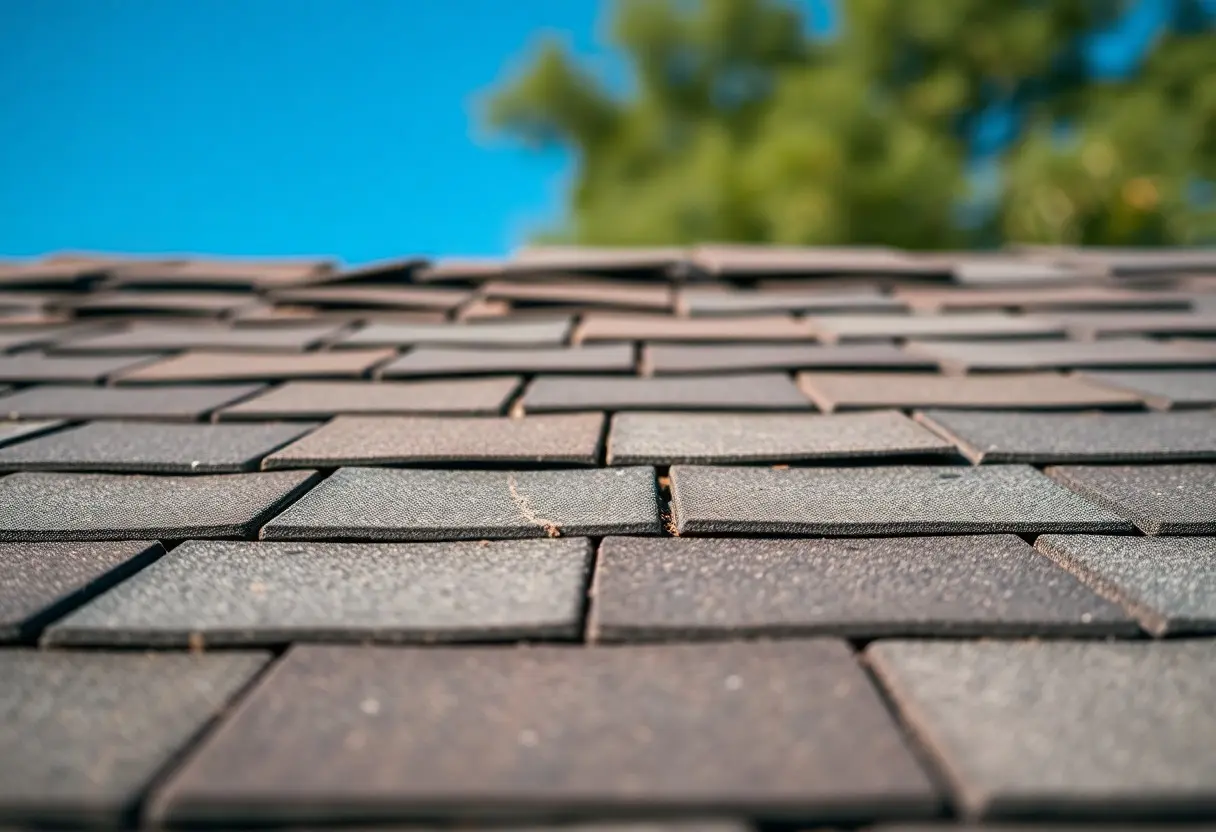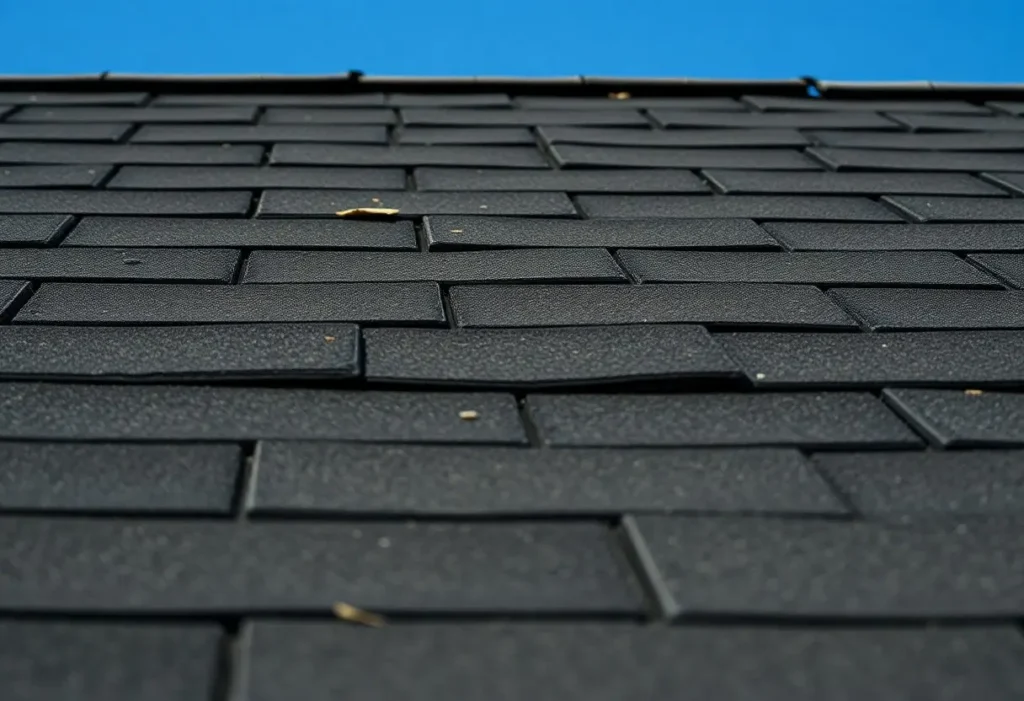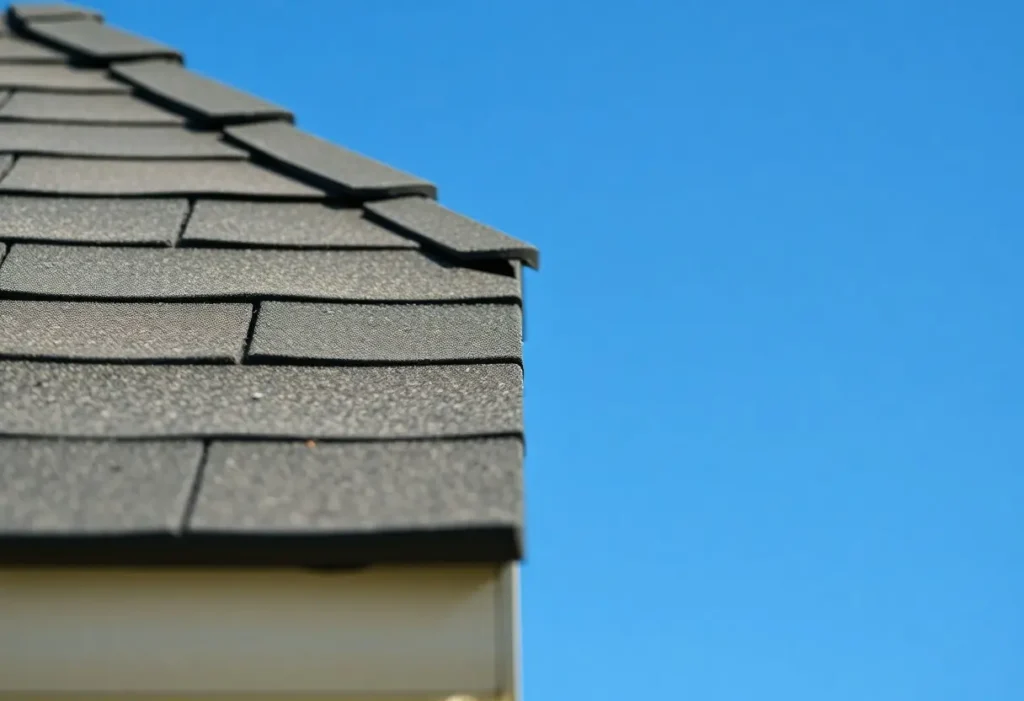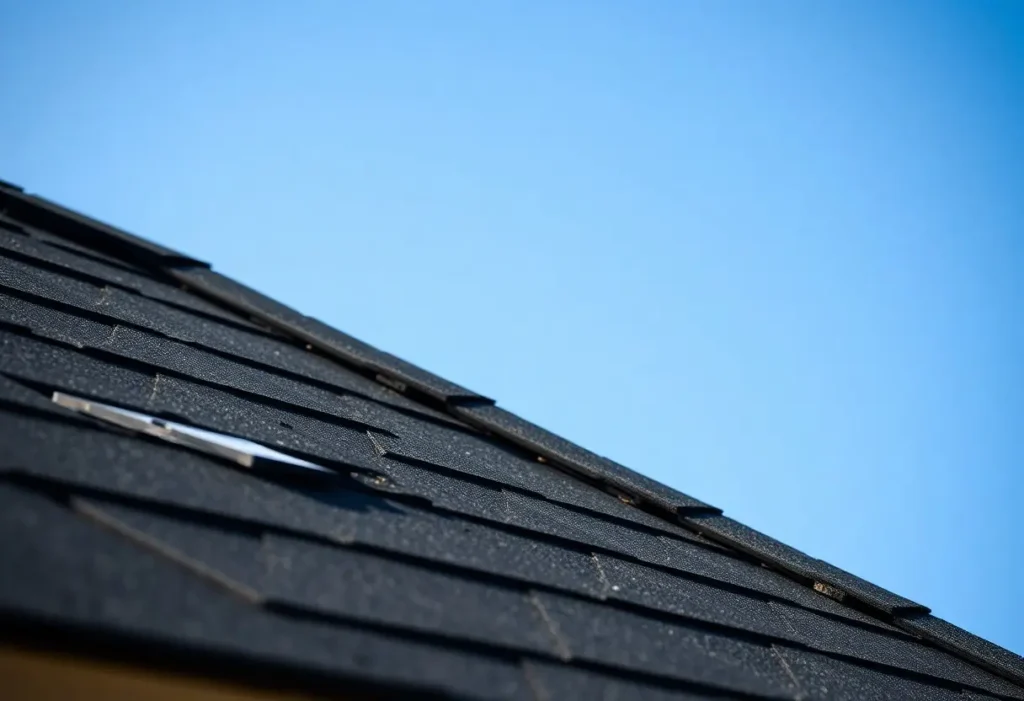How To Identify Common Asphalt Roof Issues

Just as every home needs maintenance, your asphalt roof also requires periodic inspection to ensure it remains in top condition. Identifying common issues like leaks, curling shingles, or moss growth can prevent costly repairs down the line. By being proactive and aware of these potential problems, you can safeguard your home, enhance its curb appeal, and extend the lifespan of your roof. In this post, you’ll learn how to recognize these typical asphalt roof issues and take appropriate action.
Key Takeaways:
- Regular inspections can help you spot leaks, cracks, and wear before they lead to major repairs.
- Look for displaced or broken shingles, as these can expose your roof to water damage.
- Check for signs of granule loss in shingles, which may indicate the aging of the roof and reduced protection.
- Pay attention to flashing around chimneys and vents; damaged or improperly installed flashing can lead to leaks.
- Examine the gutters for debris and proper drainage, as clogged gutters can contribute to roof damage over time.
The Telltale Signs of Asphalt Deterioration
Identifying Surface Wear Patterns
Surface wear on your asphalt roof can manifest as a generalized thinning of the material, coupled with noticeable color fading. You may observe that the roof surface has altered from its original deep black to a lighter shade of gray, which indicates the loss of protective granules. These granules help shield the underlying asphalt from UV radiation, so any visible granule loss is a signal that your roof is aging prematurely. Keep an eye out for uneven patches as well; they may indicate trapped moisture or areas where the material has started to break down.
Another pattern to look for is shiny or smooth sections compared to textured areas. This change in surface texture often suggests that the granules have worn away, exposing the underlying asphalt to the elements. Check for raised or curled edges along the shingles, which can be a sign of improper installation or age-related issues. Any significant changes in texture or color can also indicate potential leaks or compromised areas that need immediate attention.
Spotting Cracks and Missing Granules
Cracks on your asphalt roof can develop due to thermal expansion, contraction, or simply as a result of age. You should examine your roof for both small cracks and larger fissures, as these can lead to water infiltration and further damage if not addressed. Missing granules can often be found in gutters or downspouts, indicating that your roof’s effective barrier has been compromised. As the granules disappear, you increase the risk of water damage to the underlying structure, creating an ongoing cycle of repair and deterioration.
Inspecting your roof regularly can help you catch these issues early. Look for signs of granule loss near the roof’s edges or in depressions, which can accumulate debris. If you see soccer ball-sized areas devoid of granules or a general loss of granulation across the surface, it’s likely your roof is approaching the end of its functional lifespan. Act promptly by contacting a roofing professional who can evaluate the extent of the damage and recommend appropriate solutions.
Granule loss exposes your asphalt layers and significantly reduces your roof’s reflective capabilities, which could lead to heat buildup inside your attic and increased cooling costs during the summer. Additionally, watch for clumps of granules pooling in valleys or around roof features. If you find these on a consistent basis, it could indicate that your roof is nearing the point of needing replacement. Addressing these signs sooner rather than later can save you from more extensive repairs and costly water damage down the line.
Uncovering Leaks Before They Escalate
Identifying leaks early can save you significant expenses and headaches down the line. Water intrusion may initially seem like a minor issue, but left unchecked, it can lead to extensive damage, including mold growth and structural compromise. When inspecting your asphalt roof, you’ll want to look for areas that are particularly susceptible to water entry. This includes places where different materials meet, such as chimneys, vents, and skylights. Additionally, any cracks or blisters in the roof’s surface can indicate underlying issues vulnerable to leaking.
Common Leak Entry Points to Inspect
Pay close attention to the flashing around chimneys and vent pipes, as these are frequent culprits for leaks. Flashing acts as a barrier between joints that are prone to water exposure. Stainless steel or aluminum flashing can corrode or crack, resulting in gaps that allow water infiltration. Also, inspect the lower edges of valleys and gutters, where debris often accumulates, causing blockages that trap water and lead to leaks. This accumulation heightens the risk of water pooling, which can seep under the shingles.
Seasonal Leak Inspection Checklist
Creating a seasonal checklist is an effective way to ensure your roof remains in optimal condition. This checklist should include inspecting your asphalt roof for visible wear and tear following significant weather events, such as heavy rains or snowfall. Look for missing or loose shingles, blisters, and signs of roof sagging, which may indicate moisture has penetrated more deeply. Taking the time to regularly examine your roof can help you catch any issues before they develop into costly repairs.
As seasons change, different factors can affect the integrity of your roof. For instance, after winter, you should search for any ice damming or damage caused during the colder months. Spring inspections can focus on the ramifications of seasonal rains that might have deteriorated roof components. During summer, pay attention to the impact of high temperatures and UV exposure. As part of your seasonal checklist, document your findings and schedule repairs promptly to fend off potential leaks.
The Impact of Weather on Asphalt Lifespan
Weather conditions play a significant role in determining the lifespan of your asphalt roof. Both extreme temperatures and moisture levels can lead to accelerated wear and tear, compromising the roof’s integrity over time. Understanding how these elements interact with your roofing material enables you to make informed decisions regarding maintenance and repairs, ultimately extending the life of your investment.
How Extreme Temperatures Affect Material Integrity
| Temperature Impact | Effects on Asphalt |
|---|---|
| High Temperatures | Can cause asphalt to become brittle, leading to cracks and surface flaking. |
| Low Temperatures | May result in shrinkage, creating gaps between seams that allow water intrusion. |
High temperatures tend to soften asphalt, making it pliable but also susceptible to deformation. If your roof frequently endures extreme heat, you might notice areas where the granules have dislodged, exposing the underlayment to harmful UV rays. Lower temperatures, conversely, lead to the hardening of the material, which can escalate issues related to brittle cracking as moves aren’t easily accommodated. Regular inspections during seasonal changes can help catch these variations early.
The Role of Moisture in Roof Decay
Moisture is one of the primary enemies of asphalt roofing systems. Over time, water can infiltrate small cracks and seams, fostering conditions that encourage rot, mold, and mildew. When left unaddressed, moisture accumulation can lead to extensive damage, necessitating costly repairs or even complete roof replacements.
Although asphalt is designed to shed rainwater, continuous exposure to moisture can weaken its structural elements. If water stands for extended periods, green algae or other organic growth can establish itself, further degrading the roofing material. Implementing proper drainage systems and maintaining the roof’s slope can mitigate long-term moisture-related issues, helping to preserve the life of your asphalt roofing system.

Maintenance Strategies to Extend Roof Life
Best Practices for Regular Inspections
Conducting regular inspections of your asphalt roof can make a substantial difference in its longevity. Aim for at least two inspections per year, ideally in the spring and fall, as these seasons can reveal the most damage caused by winter storms and summer heat. During your inspections, look for signs of wear such as cracked or missing shingles, granule loss, and any visible structural damage to the roof deck. Use binoculars for a closer look from the ground, but don’t hesitate to access your roof safely if it’s feasible.
Pay special attention to areas that are more prone to problems, such as valleys, flashing, and around vents. Irrigation systems and trees that overhang your roof could also pose risks, so trimming back branches and ensuring proper water runoff can mitigate further harm. An effective strategy involves keeping a written record of your inspections and any repairs, as this historical data can help you track performance and anticipate future issues.
Essential Repairs to Address Minor Issues
Addressing minor issues promptly can save you from costly repairs later on. If you notice any loose or missing shingles, replace them as soon as possible to prevent further exposure to the underlying materials. A simple caulking job can effectively seal minor gaps around chimneys and vents, reducing the likelihood of leaks forming. Additionally, keeping roof valleys clear of debris during your inspections will help ensure that water flows off the roof properly, minimizing the risk of water pooling and causing rot.
Small cracks in the shingles should not be ignored; applying a roof sealant can provide a temporary fix that can extend the life of your roof until a complete replacement is necessary. For homeowners with limited maintenance experience, hiring a professional for necessary repairs can guarantee proper workmanship and materials, enabling you to confidently address common challenges.

When to Call in the Professionals
Signs That Indicate Professional Assessment is Necessary
You may notice subtle signs that indicate it’s time to bring in a professional for your asphalt roof. If you observe curling or buckling shingles, this often means the material is near the end of its lifecycle. Additionally, persistent granule loss, where you find bits of shingle in your gutters, suggests underlying issues that only a thorough assessment can reveal. Dark streaks or areas of discoloration signal potential mold or algae infestations, which can compromise the roof structure. If multiple signs appear simultaneously, like leaks in multiple areas, the urgency increases, indicating that it’s not merely a surface problem.
Another critical sign is if you find water stains or peeling paint on the interior ceilings and walls of your home. This can mean water has already penetrated your roof and is doing considerable damage to your home’s interior. Missing shingles during a routine visual check can point to wind damage or improper installation, and if you’re unsure about the integrity of your roof after a severe storm, your best course of action is to consult with a professional. Investing in an inspection now could save you significant costs down the road.
What to Expect from a Roofing Inspection
During a roofing inspection, professionals will conduct a comprehensive evaluation, both from the ground and on the roof itself. You can expect them to assess the overall condition of the shingles, checking for any signs of wear or damage while also inspecting the flashing around chimneys and vents for leaks. A qualified inspector will also examine the insulation and ventilation in your attic, as these elements play a significant role in the long-term health of your asphalt roof. An assessment typically takes about 30 minutes to an hour, depending on the roof’s complexity and the extent of issues present.
Once the inspection is complete, you’ll receive a detailed report including photographs of areas of concern, potential problems, and recommendations for repairs or replacements. Pros provide accurate forecasts of the remaining lifespan of your roof and outline the best maintenance strategies tailored to your specific needs. This proactive approach can not only extend the life of your roof but also prevent unexpected and costly repairs in the future.
What to expect from a roofing inspection is an organized, methodical evaluation to ensure every component of your asphalt roof is thoroughly examined. The inspector’s expertise is invaluable and can often reveal hidden issues that aren’t visible to the untrained eye. Armed with this information, you gain peace of mind and a clear understanding of your roof’s condition and the necessary next steps
FAQs about Common Asphalt Roof Issues
What are the signs of wear and tear on an asphalt roof?
Signs of wear and tear on an asphalt roof include curling or buckling shingles, missing granules that expose the underlying layer, and cracked or broken shingles. Additionally, look for any dark spots or discoloration, which can indicate moisture or algae growth. Keeping an eye on these signs can help identify potential issues before they escalate. Signs of wear and tear on an asphalt roof include curling or buckling shingles, missing granules that expose the underlying layer, and cracked or broken shingles. Additionally, look for any dark spots or discoloration, which can indicate moisture or algae growth. Keeping an eye on these signs can help identify potential issues before they escalate.
How can I tell if my asphalt roof is leaking?
Signs of a leaking asphalt roof may include water stains on ceilings and walls, which suggest that water is penetrating from the roof. Inside your attic, check for damp insulation or visible mold growth, which could indicate water infiltration. Also, be on the lookout for any noticeable drips during heavy rain, as these can be a clear indication of a leak.
What should I do if I spot sagging on my roof?
If you notice sagging in your asphalt roof, it is important to address this issue promptly. Sagging can indicate structural damage or excess weight from improper drainage or accumulation of debris. First, ensure that gutters and downspouts are clear and functioning properly. It is advisable to contact a roofing professional to assess the extent of the sagging and recommend necessary repairs.
Are there specific weather conditions that can damage asphalt roofs?
Yes, extreme weather conditions can adversely affect asphalt roofs. Intense heat can cause shingles to dry out and crack, while heavy rain can lead to water pooling and leaks. Hailstorms can result in significant damage to the shingles, causing dents or cracks. Additionally, strong winds can lift or remove shingles. Regular inspections following severe weather are recommended to identify any potential damage.
How often should I inspect my asphalt roof for issues?
It is advisable to inspect your asphalt roof at least twice a year, typically in the spring and fall, to identify any potential issues early. After severe weather events, additional inspections may be warranted. Early detection of issues like curling shingles, staining, or debris accumulation can prevent costly repairs and extend the lifespan of your roof.

Summing up
With these considerations, you can effectively identify common asphalt roof issues before they escalate into more significant problems. Regular inspections, understanding the signs of wear and tear, and paying attention to your roof’s performance are key steps in maintaining your roof’s integrity. This proactive approach not only enhances your home’s curb appeal but also extends the lifespan of your roof, saving you time and financial resources in the long run.
Being vigilant about potential issues such as leaks, blistering, or curling shingles can empower you to take timely action. Whether you decide to address these problems yourself or seek professional help, having the knowledge to identify these issues will lead to better maintenance decisions. Ultimately, a well-cared-for asphalt roof will provide you with peace of mind and protection for your home for years to come.
Trust All Weather Exteriors for Expert Solutions
When it comes to your home, the roof is your first line of defense against the elements. Asphalt roofs, while durable and cost-effective, can develop a range of issues over time. Knowing how to identify these problems early can save you significant time and money on repairs. Common signs of trouble include curling shingles, granule loss, water stains, and leaks. If you notice any of these issues, it’s not just an aesthetic problem; it could lead to more severe damage.
That’s where All Weather Exteriors comes in. With years of experience in diagnosing and repairing asphalt roof issues, our team is committed to keeping your home safe and secure. We use high-quality materials and the latest techniques to ensure your roof is not only restored but fortified against future wear and tear. Don’t wait for small problems to escalate into costly repairs. Contact All Weather Exteriors today, and let us help you enjoy peace of mind through reliable roofing solutions!

Leave a Reply
You must be logged in to post a comment.